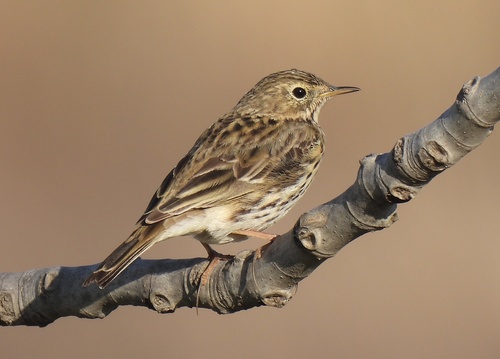
Meadow Pipit
The Meadow Pipit (*Anthus pratensis*) is a small, unassuming passerine bird, widespread across Europe and parts of Asia. Often overlooked due to its cryptic plumage, it plays a crucial ecological role as both predator and prey in grassland and moorland ecosystems. It is a key indicator species, meaning its population trends can reflect the health of the wider environment. While not culturally prominent in folklore like some birds, it is a familiar sight to those who frequent open countryside and is appreciated by birdwatchers for its delicate song and aerial displays.
14-15 cm
Length
22-25 cm
Wingspan
Near Threatened
Conservation Status
Distribution
Breeds across much of Europe and northern Asia, extending from Greenland and Iceland in the west to Siberia in the east. Northern populations are migratory, wintering in southern Europe, North Africa, and the Middle East. Altitudinal range varies, found from sea level to high mountain meadows.
Lifespan
Typically 2-3 years in the wild, but individuals up to 8 years old have been recorded.
Meadow Pipit's Habitat
Habitat Types
Grasslands, Moorlands, Heathlands, Tundra, Agricultural fields (particularly pastures)
Climate Zones
Temperate, Boreal, Subarctic
Adaptations
Cryptic plumage provides excellent camouflage in grassland environments. Strong legs and relatively long toes are adapted for walking and running on the ground, where it spends much of its time.
Variations
Several subspecies have been proposed, but differences are subtle, primarily involving slight variations in plumage tone and size. Further research is needed to clarify subspecific relationships.
Appearance
Breeding Plumage
Subtle differences; breeding plumage may be slightly brighter with more distinct streaking.
Seasonal Feather Changes
Wear and tear can make plumage appear duller outside the breeding season.
Sex Based Plumage Differences
Males and females are very similar in appearance.
Notable Features
Streaked brown upperparts, Pale underparts with dark streaks on the breast and flanks, Thin, pointed bill, White outer tail feathers (visible in flight)
Diet and Feeding
Primary Foods
Insects, Spiders, Small invertebrates, Seeds (especially in winter)
Foraging Behavior
Primarily forages on the ground, walking and running to pick up prey. Will occasionally make short flights to catch flying insects.
Specializations
No highly specialized feeding adaptations; a generalist insectivore.
Seasonal Diet Variations
Diet shifts to include more seeds during the winter months when insect availability is reduced.
Behavior
Social Structure
Generally solitary or in pairs during the breeding season. Forms small flocks in winter, sometimes mixing with other pipit or lark species.
Communication
A thin, high-pitched 'tseep' call, A complex song delivered during flight displays, Alarm calls given when predators are near
Migration
Northern populations are migratory, undertaking long-distance flights to wintering grounds. Southern populations may be resident or only partially migratory.
Territorial or Group Behaviors
Males defend breeding territories through song and aerial displays. Less territorial outside the breeding season.
Conservation
Threats
Habitat loss and degradation (due to agricultural intensification, afforestation, and urbanization), Climate change (affecting breeding success and migration patterns), Pesticide use (reducing insect prey availability)
Protection Programs
Agri-environment schemes (promoting wildlife-friendly farming practices), Habitat restoration projects, Monitoring programs to track population trends
Local National Laws
Protected under various national and international wildlife legislation, such as the EU Birds Directive.
Population Trend
Decreasing
Population Estimates
Global population estimated to be 15,000,000-39,999,999 mature individuals
Interesting Facts
Meadow Pipits are a frequent host of the Common Cuckoo
Cuckoos lay their eggs in Meadow Pipit nests, leaving the pipits to raise the cuckoo chicks.
They can be difficult to identify from other pipit species.
Careful observation of plumage details, call, and behavior is needed to distinguish them.
The Meadow Pipit is one of the most important prey species for the Merlin
The small falcon species relies heavily on the pipit, especially during winter months.
Faqs about Meadow Pipit
What is the difference between a Meadow Pipit and a Skylark?
Skylarks are larger, have a crest (which Meadow Pipits lack), and have a more elaborate song delivered from a greater height.
Where can I see Meadow Pipits?
Look for them in open habitats like grasslands, moorlands, and farmland, particularly during the breeding season.
Are Meadow Pipits endangered?
They are currently classified as Near Threatened by the IUCN, meaning they are close to qualifying for a threatened category.
How can I help Meadow Pipits?
Supporting conservation organizations that work to protect grassland habitats and promote sustainable farming practices can benefit Meadow Pipits.
Copyright @ Nature Style Limited. All Rights Reserved.
 English
English